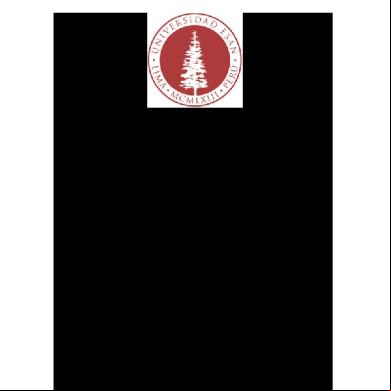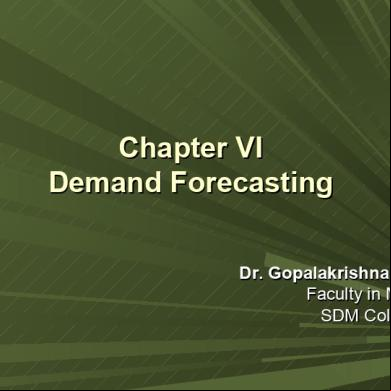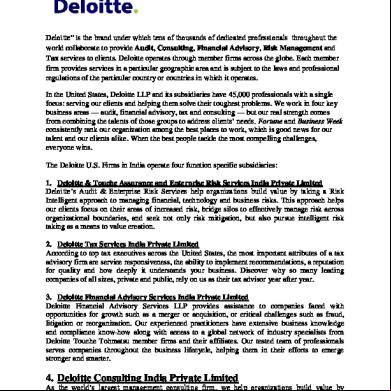Fashion Forecasting Process 41d5j
This document was ed by and they confirmed that they have the permission to share it. If you are author or own the copyright of this book, please report to us by using this report form. Report 3b7i
Overview 3e4r5l
& View Fashion Forecasting Process as PDF for free.
More details w3441
- Words: 899
- Pages: 27
c c
a
c ‡ Locate the spawning grounds of trends ‡ Identify emerging concepts ‡ Fashion information ed on to other forecasters, product developers, marketers and the press work for all kinds of firms
Y
i.e. a window of opportunity ‡ timing a firm¶s product offerings to the customer¶s readiness and willingness to accept and adopt those products.
‡ Forecasting should identify: a. Source b. Underlying Pattern c. Direction d. Tempo ‡ Forecasting attempts to project past trends into the future ‡ Anticipates future developments by watching for signals of change in current situations
c ‡ Can be emerging, building or declining ‡ It has identifiable similarities across information sources. (styles, details, etc etc)) ‡ Characterized by a building awareness among consumers
‡ Short trend (a trend with a short duration) ‡ Accepted among a relatively small contingent of consumers ‡ Fades quickly because it isn¶t ed the corresponding lifestyle changes.
‡ Long trend ‡ Any item or style that gains visibility, generates multiple purchases, and reaches a plateau level of widespread acceptance that persists over a long period of time. ‡ Classics implement core attributes desireable while avoiding extreme styling
r
‘elps forecasters understand and communicate the movement of fashion and project future directions. There are 3 most familiar patterns of visualization.
‡ Fashion Curves ‡ Pendulum Swing ‡ Fashion Cycles
‡ Trends are classified in duration and penetration which are visualized by a curve ‡ Time is on the horizontal axis ‡ consumer adoption is on the vertical axis
Y Y ‡ Refers to periodic movement of fashion between extremes. Ex. Power dressing in the 80s moved on to relaxed dress codes.
‡ The idea that there exist cyclical patterns in fashion that reoccur over time and are discernible. ‡ The reoccurring patterns are called long wave phenomenon
6Y c
6Y ë. Identify the basic facts about past trends and forecasts 2. Determine the causes of change in the past 3. Determine the difference between past forecasts and actual behaviors 4. Determine the factors likely to affect trends in the future
6Y Õ. Apply forecasting tools and techniques while paying attention to issues of accuracy and reliability 6. Follow the forecast continually to determine reasons for significant deviations from expectations 7. Revise the forecast when necessary
0 c Y c
0 c ‡ Õ years or more ‡ Timeline sufficient for decisions related to repositioning or extending product lines ‡ Initiating new businesses ‡ Reviving brand images ‡ Planning new retain concepts
Y
c
‡ ë year + ‡ Timeline allows for the segments of the textile / apparel pipeline to coordinate seasonal goods around looks that can be communicated to the customer through the press and stores
c
Y ‡ Following the latest fashion news to spot emerging fashion & lifestyle trends ‡ Focus on color, textiles or style forecasting
Y ‡ Attempts to identify clusters of people who share Characteristics ‡ Usually combined with demographics, lifestyle, attitudes and behavior ‡ Used to determine target market ‡ Can be used to better understand consumer behavior
‡ Combines FASHION SCAN and CONSUMER SCAN to determine what is likely to happen next brings together expertise of a fashion insider & the insights of consumer behavior
Y c ‡ Cultural changes in society involve shifts in lifestyle and reflect changes in generational cohorts or cycles in the economy ‡ Affects mass scale purchasing decisions ‡ Casual lifestyle, trend resistant consumer ‡ Megatrends- large scale shifts that cross industry lines
c ‡ Detects short & long term trends that affect business prospects ‡ Uses all of the aforementioned tools: ‡ Fashion Scan ‡ Consumer Scan ‡ Fashion Analysis ‡ Social and Economic Trends ‡ Trend Analysis
‡ Researches the plans and capabilities of competing firms by tracing public information sources. ‡ Over time this allows for the benchmarking of activities against competitors and to develop an accurate view of the market environment.
! "cY c # ‡ All cultural components respond to the spirit of the times ‡ The power of the zeitgeist is the ability to coordinate across product categories ‡ Fashion affects all product categories ‡ Individuals in large numbers choose among competing styles; they choose those styles that click or connect with the spirit of the times.
a
c ‡ Locate the spawning grounds of trends ‡ Identify emerging concepts ‡ Fashion information ed on to other forecasters, product developers, marketers and the press work for all kinds of firms
Y
i.e. a window of opportunity ‡ timing a firm¶s product offerings to the customer¶s readiness and willingness to accept and adopt those products.
‡ Forecasting should identify: a. Source b. Underlying Pattern c. Direction d. Tempo ‡ Forecasting attempts to project past trends into the future ‡ Anticipates future developments by watching for signals of change in current situations
c ‡ Can be emerging, building or declining ‡ It has identifiable similarities across information sources. (styles, details, etc etc)) ‡ Characterized by a building awareness among consumers
‡ Short trend (a trend with a short duration) ‡ Accepted among a relatively small contingent of consumers ‡ Fades quickly because it isn¶t ed the corresponding lifestyle changes.
‡ Long trend ‡ Any item or style that gains visibility, generates multiple purchases, and reaches a plateau level of widespread acceptance that persists over a long period of time. ‡ Classics implement core attributes desireable while avoiding extreme styling
r
‘elps forecasters understand and communicate the movement of fashion and project future directions. There are 3 most familiar patterns of visualization.
‡ Fashion Curves ‡ Pendulum Swing ‡ Fashion Cycles
‡ Trends are classified in duration and penetration which are visualized by a curve ‡ Time is on the horizontal axis ‡ consumer adoption is on the vertical axis
Y Y ‡ Refers to periodic movement of fashion between extremes. Ex. Power dressing in the 80s moved on to relaxed dress codes.
‡ The idea that there exist cyclical patterns in fashion that reoccur over time and are discernible. ‡ The reoccurring patterns are called long wave phenomenon
6Y c
6Y ë. Identify the basic facts about past trends and forecasts 2. Determine the causes of change in the past 3. Determine the difference between past forecasts and actual behaviors 4. Determine the factors likely to affect trends in the future
6Y Õ. Apply forecasting tools and techniques while paying attention to issues of accuracy and reliability 6. Follow the forecast continually to determine reasons for significant deviations from expectations 7. Revise the forecast when necessary
0 c Y c
0 c ‡ Õ years or more ‡ Timeline sufficient for decisions related to repositioning or extending product lines ‡ Initiating new businesses ‡ Reviving brand images ‡ Planning new retain concepts
Y
c
‡ ë year + ‡ Timeline allows for the segments of the textile / apparel pipeline to coordinate seasonal goods around looks that can be communicated to the customer through the press and stores
c
Y ‡ Following the latest fashion news to spot emerging fashion & lifestyle trends ‡ Focus on color, textiles or style forecasting
Y ‡ Attempts to identify clusters of people who share Characteristics ‡ Usually combined with demographics, lifestyle, attitudes and behavior ‡ Used to determine target market ‡ Can be used to better understand consumer behavior
‡ Combines FASHION SCAN and CONSUMER SCAN to determine what is likely to happen next brings together expertise of a fashion insider & the insights of consumer behavior
Y c ‡ Cultural changes in society involve shifts in lifestyle and reflect changes in generational cohorts or cycles in the economy ‡ Affects mass scale purchasing decisions ‡ Casual lifestyle, trend resistant consumer ‡ Megatrends- large scale shifts that cross industry lines
c ‡ Detects short & long term trends that affect business prospects ‡ Uses all of the aforementioned tools: ‡ Fashion Scan ‡ Consumer Scan ‡ Fashion Analysis ‡ Social and Economic Trends ‡ Trend Analysis
‡ Researches the plans and capabilities of competing firms by tracing public information sources. ‡ Over time this allows for the benchmarking of activities against competitors and to develop an accurate view of the market environment.
! "cY c # ‡ All cultural components respond to the spirit of the times ‡ The power of the zeitgeist is the ability to coordinate across product categories ‡ Fashion affects all product categories ‡ Individuals in large numbers choose among competing styles; they choose those styles that click or connect with the spirit of the times.










